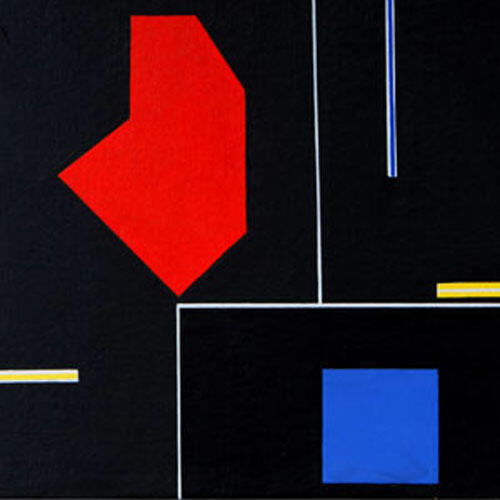Juan Melé
Galerie Argentine, Paris
The consistency of the work produced by Juan Melé harmonizes with the exhibition space in the Galerie Argentine − Argentine Embassy. In a curatorial exercise detached from chronological organizations, the show develops organically amidst paintings, sculptures and engravings. On entering the exhibit, we are faced with works in a diversity of media and dimensions contrasting in the environment that contains them. Colors, lines and forms dance on the surface, presenting a lively collection of geometric shapes. A dark line delicately divides the background in two; touches of yellow, black, white, blue and a red form cover the surface. The staging of the show is impeccable, and so is the facture of each work. The ensemble features different instances of the artist’s trajectory, which immediately capture the spectator’s gaze and allow him/her to enter once again in the prodigious world of the artist’s creations.

Melé’s itinerary and the vastness of his oeuvre are inseparable from concrete painting, the point of departure of abstraction in Argentine art of the 1940s, a crucial stage not only in the art of that country but also in that of the whole of Latin America. It marked a perspective of rupture and novelty which has persisted in present-day art. In Argentina, the beginning was marked by Arturo magazine, when in 1944 it signaled the emergence of geometric abstraction, which gathered together visual artists and poets, and designed the tenets which guided the Arte Concreto-Invención Group .
Sharing the same aspirations, Melé stood out as an active participant in the defense of this non-figurative art with which he aligned as of 1946, and from that moment on, his work has been in constant evolution. Characterized by the formal synthesis of color, it materializes the symmetry between color and form. We are faced with the renovation of sensibility and creativity alongside the concrete and the real, as the artist demonstrates his inventive capacity to embody these values. The wish to create new objects confirms Melé’s intention to incorporate art in the vital praxis. The forms are emphasized subtly but with certain strength; the proportionality of the geometric figures and color intertwine with rational intensity. The imprint of the brush is absent; paint is applied in planar colors and with a perfect finish. His work is thus centered on a new degree of knowledge imbued with great sensibility: the compositional rigor he abides by from a constructive concept of the image to a fragmented and dynamic re-composition, aimed at certain perceptive stimuli that manifest themselves as metaphors for present-day life.
It is no secret that Melé’s overwhelming vitality drives him away from peacefulness. Between 1949 and 1950, he resided in Paris, where he came into contact with Vantongerloo, Brancusi, Pevsner and Sonia Delaunay. During that period, he traveled to different European art centers: Italy, Switzerland, and Spain; he met the members of the Concrete Group in Milan, and made the acquaintance of Max Bill. Back in Buenos Aires, he began an intense activity as a teacher and engaged in a fruitful artistic production. Later on, in the 1960s, there came a succession of trips (New York, Buenos Aires, Paris, Buenos Aires), a time when he developed his different stages and was represented in public and private collections.
Together with the other members of the Arte Concreto-Invención Group, Melé opened new horizons for the art of his time, responding to the avant-garde conjunctures and proposing to break with the classic forms: leaving the pictorial space and entering into the real. To discover the wish to participate in the world convinced of the utopia in which industrial design and art would be one and the same thing. A whole artist’s life abiding by compositions of a structural rigor that have slowly evolved and that announce a universal language, the one of the line and the plane hand in hand with the rigor of the scientific method. With discretion and curiosity, he holds the course of his artistic choice without − unlike others − causing controversy and turbulence. He conserves his energy to focus it on his work.
Characterized by an image that identifies him and endowed with a singular ability to invent atmospheres through an admirable handling of composition, of the pictorial space, of a fine draftsmanship and of color, Melé creates suggestive works. The carefully delimited pigments generate a feeling of restrained emotion. The different colors remain in their individual cells, taking care not to trespass on those that do not correspond to them. A tireless researcher, his work is aimed at producing in the viewer an entirely original visual sensation, subjecting him/her to a simple, direct, and immediate experience. Paintings-objects, sculptures or engravings, all his works have the same insinuating charm.
The history of painting and of visual experimentation is always a history of the origin of seeing. Juan Melé configured, together with other artists, the abstract and concrete gaze on an objective reality, diversifying his work into different interpretations such as graphic art and architectonic spatiality. Through form, the void, and the pure firmness of color, he manages to make us see that which it was impossible to see: that through its maximum abstraction reality can be taken beyond the plane.
-
 Juan Melé. Sin titulo, 1991 Acrylic on borrad/Acrílico sobre madera
Juan Melé. Sin titulo, 1991 Acrylic on borrad/Acrílico sobre madera




